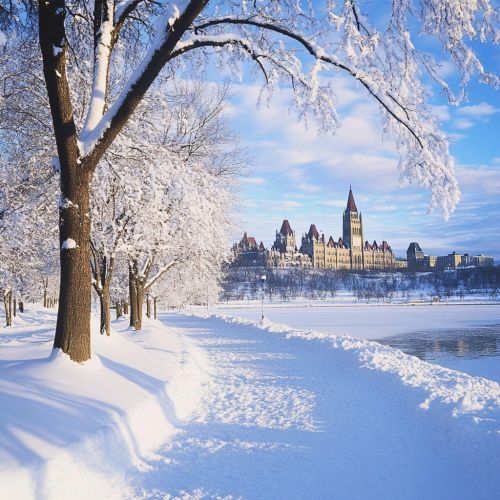Climate of Ottawa
Climate of Ottawa


Ottawa, the capital city of Canada, experiences a humid continental climate (Köppen climate classification Dfb) characterized by four distinct seasons: cold winters, warm summers, and transitional spring and autumn periods. This article delves into the various aspects of Ottawa's climate, including temperature variations, precipitation patterns, seasonal changes, and the impact of climate change.
Temperature
Ottawa's climate is marked by significant temperature variations throughout the year. Winters are typically cold, with average temperatures in January ranging from -10°C to -5°C. The city often experiences cold snaps, with temperatures occasionally dropping below -20°C due to Arctic air masses. Conversely, summers are warm, with average temperatures in July ranging from 15°C to 25°C. Heatwaves are not uncommon, and temperatures can occasionally exceed 30°C, influenced by continental air masses.
The diurnal temperature variation in Ottawa is also notable, particularly during the transitional seasons of spring and autumn. During these periods, daytime temperatures can be significantly higher than nighttime temperatures, sometimes by as much as 15°C to 20°C.
Precipitation
Ottawa receives a moderate amount of precipitation throughout the year, averaging approximately 940 millimeters annually. Precipitation is relatively evenly distributed across the months, with slightly higher amounts during the summer months due to convective thunderstorms. These thunderstorms can be intense, occasionally leading to localized flooding.
Winter precipitation primarily falls as snow, with Ottawa receiving an average of 235 centimeters of snowfall annually. Snow cover typically lasts from late November to early April, with the peak snow depth occurring in February. The city's snow removal operations are extensive, given the volume of snow and the need to maintain transportation infrastructure.
Seasonal Changes
Winter
Winter in Ottawa is characterized by cold temperatures, frequent snowfall, and extended periods of snow cover. The season typically begins in late November and lasts until early April. During this period, the city experiences several snowstorms, often accompanied by strong winds and reduced visibility. The wind chill factor can make temperatures feel significantly colder than the actual air temperature.
Spring
Spring in Ottawa is a transitional season, marked by gradually warming temperatures and melting snow. The season usually begins in April and lasts until early June. During this period, the city experiences a mix of rain and occasional snow showers. The melting snow and increased rainfall can lead to spring flooding, particularly in low-lying areas and along the Ottawa River.
Summer
Summer in Ottawa is warm and humid, with temperatures frequently exceeding 25°C. The season typically lasts from late June to early September. During this period, the city experiences longer daylight hours and higher humidity levels. Thunderstorms are common, particularly in the late afternoon and evening. These storms can bring heavy rainfall, lightning, and occasionally hail.
Autumn
Autumn in Ottawa is another transitional season, characterized by cooling temperatures and changing foliage. The season usually begins in late September and lasts until late November. During this period, the city experiences a mix of sunny and rainy days, with temperatures gradually decreasing. Frost can occur as early as late September, and the first snowfall usually happens in November.
Climate Change
The impact of climate change on Ottawa's climate is becoming increasingly evident. Over the past few decades, the city has experienced a gradual increase in average temperatures, particularly during the winter months. This warming trend has led to shorter winters, reduced snow cover, and earlier spring thaws. Additionally, the frequency and intensity of extreme weather events, such as heatwaves and heavy rainfall, have increased.
The Intergovernmental Panel on Climate Change (IPCC) projects that these trends will continue, with Ottawa experiencing warmer temperatures, more frequent heatwaves, and changes in precipitation patterns. These changes pose significant challenges for the city's infrastructure, public health, and natural ecosystems.
